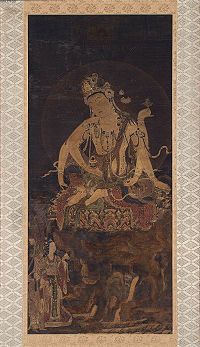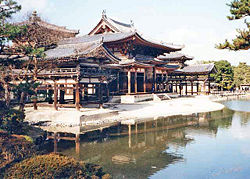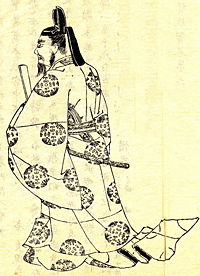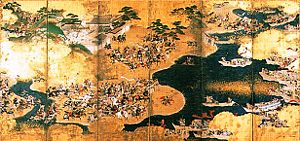Heian Period
The Heian period (å¹³å®æ代, Heian Jidai) is the last division of classical Japanese history, spanning from 794 to 1192. Heian (å¹³å®) means "peace" and "tranquility" in Japanese. During this time, Emperor Kammu supported the emergence of new Buddhist movements by sending students such as Saicho and Kukai to China during the Tang Dynasty. Each developed different kinds of esoteric Buddhism and made crucial contributions to Japanese Buddhist history.
The Heian period is also considered the peak of the Japanese imperial court and aristocratic culture, giving rise to uniquely Japanese art, poetry, and literature. Hiragana and Katakana, two sets of Japanese syllabary, were created and literary masterpieces such as the Tale of Genji were written during this time.
Throughout the Heian period the samurai class gradually gained power, and the Kamakura shogunate marked the end of the Heian period.
History
The Heian period was preceded by the Nara period and began in 794 after the movement of the capital of Japan to Heian-kyÅ (present-day Kyoto) by the 50th emperor, Emperor Kammu (Kammu TennÅ). It is considered a high point in Japanese culture that later generations have always admired. The period is also noted for the rise of the samurai class, which would eventually take power and start the feudal period of Japan.
Emperor Kammu moved the capital from Nara to Kyoto in order to prevent the political intervention of old Buddhist powers located in Nara. He also supported the overseas education of students in China during the Tang Dynasty to study new schools of Buddhism. Two of these students, Kukai and Saicho, went on to develop different schools of esoteric Buddhism.
Nominally, sovereignty lay in the emperor but in fact power was wielded by the Fujiwara nobility. However, to protect their interests in the provinces, the Fujiwara and other noble families required guards, police and soldiers. The warrior class made steady gains throughout the Heian period. As early as 939, Taira no Masakado threatened the authority of the central government, leading an uprising in the eastern province of Hitachi, and almost simultaneously, Fujiwara no Sumitomo rebelled in the west. Still, military takeover was centuries away, when much of the strength of the government would lie within the private armies of the shogunate.
The entry of the warrior class into court influence was a result of the Hogen disturbance. At this time Taira no Kiyomori revived the Fujiwara practices by placing his grandson on the throne to rule Japan by regency. Their clan (Taira clan) would not be overthrown until after the Genpei War, which marked the start of the shogunate. The Kamakura period began in 1185 when Minamoto no Yoritomo seized power from the emperors and established a bakufu, the Kamakura shogunate, in Kamakura.
Developments in Buddhism
Buddhism (BukkyÅ) was introduced from Korea and China and began to spread throughout Japan during the Heian period, primarily through two major esoteric sects: Tendai (Heavenly Terrace) and Shingon (True Word). Tendai originated in China and is based on the Lotus Sutra, one of the most important sutras of Mahayana Buddhism. Shingon is an indigenous sect with close affiliations to original Indian, Tibetan, and Chinese Buddhist thought founded by Kukai (also called Kobo Daishi). Kukai greatly impressed the emperors who succeeded Emperor Kammu (782-806), and also generations of Japanese, not only with his holiness but also with his poetry, calligraphy, painting, sculpture, and construction of irrigation ponds. Kukai established the first school in Japan that was open to all people regardless of their social rank or profession. Kukai is one of the most popular Buddhist masters in Japanese history and people continuously make pilgrimages to the places where his legacy remains. Another Buddhist master, Saicho was the leader of the Tendai sect and he made his temple a center for scholarly research. Kammu himself was a notable patron of the otherworldly Tendai sect, which rose to great power over the next few centuries. A close relationship developed between the Tendai monastery complex on Mount Hiei and the imperial court at the foot of the mountain. As a result, Tendai emphasized great reverence for the emperor and the nation.
Heian period literature
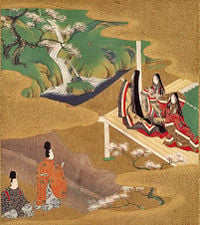
Although written Chinese (Kanbun) remained the official language of the Heian period imperial court, the introduction and wide use of kana saw a boom in Japanese literature. Despite the establishment of several new literary genre such as the novel and narrative monogatari and essays, literacy was only common among the court and Buddhist clergy.
The lyrics of the modern Japanese national anthem, "Kimi Ga Yo," were written in the Heian period, as was "The Tale of Genji" Genji Monogatari) by Murasaki Shikibu, the oldest modern novel in the world. Murasaki Shikibu's contemporary and rival Sei Shonagon's revealing observations and musings as an attendant in the Empress' court were recorded collectively as "The Pillow Book" (Makura no sÅshi) in the 990s. The famous Japanese poem known as the iroha was also written during the Heian period.
Heian period economics
While on one hand the Heian period was indeed an unusually long period of peace, it can also be argued that the period weakened Japan economically and led to poverty for all but a tiny few of its inhabitants. The aristocratic beneficiaries of Heian culture, the Yokibito meaning the Good People, numbered about five thousand in a land of perhaps five million. One reason the samurai were able to take power was that the ruling nobility proved incompetent at managing Japan and its provinces. By the year 1000 the government no longer knew how to issue currency and money was gradually disappearing. The lack of a solid medium of economic exchange is implicitly illustrated in novels of the time, for instance messengers are rewarded with useful objects, e.g., an old silk kimono, rather than paid a fee. The Fujiwara rulers also failed to maintain adequate police forces, which left robbers free to prey on travelers. This is again implicitly illustrated in novels by the terror that night travel inspired in the main characters.
The Fujiwara Regency
When Emperor Kammu Kammu TennÅ) moved the capital to Heian-kyÅ (Kyoto), which remained the imperial capital for the next 1,000 years, he did so not only to strengthen imperial authority but also to improve his seat of government geopolitically. Kyoto had good river access to the sea and could be reached by land routes from the eastern provinces. The early Heian period (794-967) continued Nara culture; the Heian capital (Kyoto) was patterned on the Chinese Tang capital at Chang'an (today's Xi'an), as was Nara, but on a larger scale. Despite the decline of the Taika-TaihÅ reforms, imperial government was vigorous during the early Heian period. Indeed, Kammu's avoidance of drastic reform decreased the intensity of political struggles, and he became recognized as one of Japan's most forceful emperors.
Although Kammu had abandoned universal conscription in 792, he still waged major military offensives to subjugate the Emishi, possible descendants of the displaced Jomon, living in northern and eastern Japan. After making temporary gains in 794, in 797 Kammu appointed a new commander under the title Seii Taishogun (barbarian-subduing generalissimo; often referred to as shogun). By 801 the shogun had defeated the Emishi and had extended the imperial domains to the eastern end of Honshu. Imperial control over the provinces was tenuous at best, however. In the ninth and tenth centuries, much authority was lost to the great families, who disregarded the Chinese-style land and tax systems imposed by the government in Kyoto. Stability came to Heian Japan, but, even though succession was ensured for the imperial family through heredity, power again concentrated in the hands of one noble family, the Fujiwara.
Following Kammu's death in 806 and a succession struggle among his sons, two new offices were established in an effort to adjust the Taika-Taiho administrative structure. Through the new Emperor's Private Office, the emperor could issue administrative edicts more directly and with more self-assurance than before. The new Metropolitan Police Board replaced the largely ceremonial imperial guard units. While these two offices strengthened the emperor's position temporarily, soon they and other Chinese-style structures were bypassed in the developing state. Chinese influence effectively ended with the last imperial-sanctioned mission to Tang China in 838. Tang China was in a state of decline, and Chinese Buddhists were severely persecuted, undermining Japanese respect for Chinese institutions. Japan began to turn inward.
As the Soga had taken control of the throne in the sixth century, the Fujiwara by the ninth century had intermarried with the imperial family, and one of their members was the first head of the Emperor's Private Office. Another Fujiwara became regent, Sessho for his grandson, then a minor emperor, and yet another was appointed Kanpaku (regent for an adult emperor). Toward the end of the ninth century, several emperors tried, but failed, to check the Fujiwara. For a time, however, during the reign of Emperor Daigo (897-930), the Fujiwara regency was suspended as he ruled directly.
Nevertheless, the Fujiwara were not demoted by Daigo but actually became stronger during his reign. Central control of Japan had continued to decline, and the Fujiwara, along with other great families and religious foundations, acquired ever larger shoen and greater wealth during the early tenth century. By the early Heian period, the shoen had obtained legal status, and the large religious establishments sought clear titles in perpetuity, waiver of taxes, and immunity from government inspection of the shoen they held. Those people who worked the land found it advantageous to transfer title to shoen holders in return for a share of the harvest. People and lands were increasingly beyond central control and taxation, a de facto return to conditions before the Taika Reform.
Within decades of Daigo's death, the Fujiwara had absolute control over the court. By the year 1000, Fujiwara no Michinaga was able to enthrone and dethrone emperors at will. Little authority was left for traditional officialdom, and government affairs were handled through the Fujiwara family's private administration. The Fujiwara had become what historian George B. Sansom has called "hereditary dictators."
Despite their usurpation of imperial authority, the Fujiwara presided over a period of cultural and artistic flowering at the imperial court and among the aristocracy. There was great interest in graceful poetry and vernacular literature. Japanese writing had long depended on Chinese ideograms (kanji), but these were now supplemented by kana, two types of phonetic Japanese script: katakana (a mnemonic device using parts of Chinese ideograms; and hiragana (a cursive form of katakana writing and an art form in itself. Hiragana gave written expression to the spoken word and, with it, to the rise in Japan's famous vernacular literature, much of it written by court women who had not been trained in Chinese as had their male counterparts. Three late tenth century and early eleventh century women presented their views of life and romance at the Heian court in "The Gossamer Years" (Kagero nikki) by "the mother of Michitsuna," "The Pillow Book" (Makura no soshi) by Sei Shonagon and "The Tale of Genji" (Genji monogatari) by Murasaki Shikibu. Indigenous art also flourished under the Fujiwara after centuries of imitating Chinese forms. Vividly colored yamato-e Japanese style paintings of court life and stories about temples and shrines became common in the mid- and late Heian periods, setting patterns for Japanese art to this day.
As culture flourished, so did decentralization. Whereas the first phase of shoen development in the early Heian period had seen the opening of new lands and the granting of the use of lands to aristocrats and religious institutions, the second phase saw the growth of patrimonial "house governments," as in the old clan system. (In fact, the form of the old clan system had remained largely intact within the great old centralized government.) New institutions were now needed in the face of social, economic, and political changes. The Taiho Code lapsed, its institutions relegated to ceremonial functions. Family administrations now became public institutions. As the most powerful family, the Fujiwara governed Japan and determined the general affairs of state, such as succession to the throne. Family and state affairs were thoroughly intermixed, a pattern followed among other families, monasteries, and even the imperial family. Land management became the primary occupation of the aristocracy, not so much because direct control by the imperial family or central government had declined but more from strong family solidarity and a lack of a sense of Japan as a single nation.
The Rise of the military class
Under the early courts, when military conscription had been centrally controlled, military affairs had been taken out of the hands of the provincial aristocracy. But as the system broke down after 792, local power holders again became the primary source of military strength. Local shoen holders had access to manpower and, as they obtained improved military technology (such as new training methods, more powerful bows, armor, horses, and superior swords) and faced worsening local conditions in the ninth century, military service became part of shoen life. Not only the shoen but also civil and religious institutions formed private guard units to protect themselves. Gradually, the provincial upper class was transformed into a new military elite based on the ideals of the bushi (warrior) or samurai (literally, one who serves).
Bushi interests were diverse, cutting across old power structures to form new associations in the tenth century. Mutual interests, family connections, and kinship were consolidated in military groups that became part of family administration. In time, large regional military families formed around members of the court aristocracy who had become prominent provincial figures. These military families gained prestige from connections to the imperial court and court-granted military titles and access to manpower. The Fujiwara clan, Taira clan, and Minamoto clan were among the most prominent families supported by the new military class.
Decline in food production, growth of the population, and competition for resources among the great families all led to the gradual decline of Fujiwara power and gave rise to military disturbances in the mid-tenth and eleventh centuries. Members of the Fujiwara, Taira, and Minamoto families - all of whom had descended from the imperial familyâattacked one another, claimed control over vast tracts of conquered land, set up rival regimes, and generally broke the peace of the Land of the Rising Sun.
The Fujiwara controlled the throne until the reign of Emperor Go-SanjÅ (1068-1073), the first emperor not born of a Fujiwara mother since the ninth century. Go-Sanjo, determined to restore imperial control through strong personal rule, implemented reforms to curb Fujiwara influence. He also established an office to compile and validate estate records with the aim of reasserting central control. Many shoen were not properly certified, and large landholders, like the Fujiwara, felt threatened with the loss of their lands. Go-Sanjo also established the Incho, or Office of the Cloistered Emperor, which was held by a succession of emperors who abdicated to devote themselves to behind-the-scenes governance, or insei (cloistered government).
The Incho filled the void left by the decline of Fujiwara power. Rather than being banished, the Fujiwara were mostly retained in their old positions of civil dictator and minister of the center while being bypassed in decision making. In time, many of the Fujiwara were replaced, mostly by members of the rising Minamoto family. While the Fujiwara fell into disputes among themselves and formed northern and southern factions, the insei system allowed the paternal line of the imperial family to gain influence over the throne. The period from 1086 to 1156 was the age of supremacy of the Incho and of the rise of the military class throughout the country. Military might rather than civil authority dominated the government.
A struggle for succession in the mid-twelfth century gave the Fujiwara an opportunity to regain their former power. Fujiwara no Yorinaga sided with the retired emperor in a violent battle in 1156 against the heir apparent, who was supported by the Taira and Minamoto (Hogen Rebellion). In the end, the Fujiwara were destroyed, the old system of government supplanted, and the insei system left powerless as bushi took control of court affairs, marking a turning point in Japanese history. In 1159, the Taira and Minamoto clashed (Heiji Rebellion), and a twenty-year period of Taira ascendancy began. The Taira were seduced by court life and ignored problems in the provinces. Finally, Minamoto no Yoritomo (1147â1199) rose from his headquarters at Kamakura (in the Kanto region, southwest of modern Tokyo) to defeat the Taira, and with them the child emperor, Emperor Antoku, in the Genpei War (1180â1185).
With Yoritomo in power, the bakufu system that would govern Japan for the next seven centuries was in place. He appointed military governors, or daimyos, to rule over the provinces, and stewards, or jito to supervise public and private estates. Yoritomo then turned his attention to the elimination of the powerful Fujiwara family, which sheltered his rebellious brother Yoshitsune. Three years later, he was appointed shogun in Kyoto formally beginning the Kamakura period.
Events
- 794: Emperor Kammu moves the capital to Heian-kyo (Kyoto)
- 804: the Buddhist monk Saicho (Dengyo Daishi) introduces the Tendai school
- 806: the monk Kukai (Kobo Daishi) introduces the Shingon (Tantric) school
- 819: Kukai founds the monastery of Mount Koya, near Kyoto
- 858: Emperor Seiwa begins the rule of the Fujiwara clan
- 1050: rise of the military class (samurai)
- 1053: the Byodo-in temple (near Kyoto) is inaugurated by emperor Fujiwara Yorimichi
- 1068: Emperor Gosanjo overthrows the Fujiwara clan
- 1087: Emperor Shirakawa abdicates and becomes a Buddhist monk, the first of the "cloistered emperors" (insei)
- 1156: Taira Kiyomori defeats the Minamoto clan and seizes power, thereby ending the "insei" era
- 1185: Taira is defeated (Gempei War) and Minamoto Yoritomo of the Hojo clan seizes power, becoming the first shogun of Japan, while the emperor (or "mikado") becomes a figurehead
- 1191: Rinzai Zen Buddhism is introduced in Japan by the monk Eisai of Kamakura and becomes popular among the samurai, the leading class in Japanese society
ReferencesISBN links support NWE through referral fees
- Adolphson, Mikael S., Edward Kamens, and Stacie Matsumoto. Heian Japan, Centers and Peripheries. Honolulu: University of Hawai'i Press, 2007. ISBN 9780824830137
- Hempel, Rose. The Golden Age of Japan, 794-1192. New York: Rizzoli, 1983. ISBN 9780847804924
- McCullough, William H., and Helen Craig McCullough. A Tale of Flowering Fortunes: Annals of Japanese Aristocratic Life in the Heian Period. Stanford, Calif: Stanford University Press, 1980. ISBN 9780804710398
- Turnbull, Stephen. The Samurai Sourcebook. Cassell, New Ed. 2000. ISBN 1854095234
- Yoda, Tomiko. Gender and National Literature: Heian Texts in the Constructions of Japanese Modernity. Durham: Duke University Press, 2004. ISBN 9780822331872
Credits
New World Encyclopedia writers and editors rewrote and completed the Wikipedia article in accordance with New World Encyclopedia standards. This article abides by terms of the Creative Commons CC-by-sa 3.0 License (CC-by-sa), which may be used and disseminated with proper attribution. Credit is due under the terms of this license that can reference both the New World Encyclopedia contributors and the selfless volunteer contributors of the Wikimedia Foundation. To cite this article click here for a list of acceptable citing formats.The history of earlier contributions by wikipedians is accessible to researchers here:
The history of this article since it was imported to New World Encyclopedia:
Note: Some restrictions may apply to use of individual images which are separately licensed.
